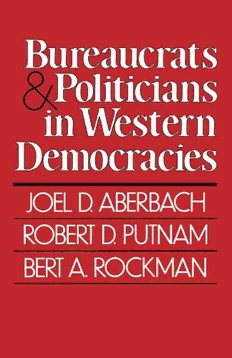
Bureaucrats and Politicians in Western Democracies (Peabody Museum) PDF
Preview Bureaucrats and Politicians in Western Democracies (Peabody Museum)
Bureaucrats and Politicians in Western Democracies Bureaucrats and Politicians . In Western Democracies Joel D. Aberbach WITHTHECOLLABORATION OF 'Thomas J. Anton Robert D. Putnam Samuel J. Eldersveld Bert A. Rockman Ronald Inglehart Harvard University Press Cambridge, Massachusetts, andLondon, England 1981 Copyright© 1981 bythe Presidentand FellowsofHarvardCollege Allrights reserved Printedinthe United StatesofAmerica LibraryofCongressCatalogingin Publication Data Aberbach, Joel D. Bureaucratsand politiciansin westerndemocracies. Includesbibliographicalreferences and index. 1. Governmentexecutives-Europe. 2. Government executives-UnitedStates. 3. POliticians-Europe. 4. Politicians-UnitedStates. I. Putnam, Robert D. II. Rockman, Bert A. III. Title. JN94.A69E92 351'.001'094 81-2899 ISBN0-674-08625-2 AACR2 For our wives Preface Inuneasypartnershipatthehelmofthe modernstate standelectedparty politicians and appointed professional bureaucrats. At least since Max Weber, politicalobservershave theorized about the relationship between politicians and bureaucrats, about theircontrastingapproaches to public policymaking. This volume confronts these theories with evidence from systematic interviews with more than 1,400 senior civil servants and members ofparliament in the United States, Britain, France, Germany, Italy, the Netherlands, and Sweden. The central question ofour book is this: How do senior bureaucrats and parliamentary politicians differ from one another and, conversely, how are they alike? Complementing this question are two others: What explains the differences and similarities between bureaucrats and politi cians? and What do these differences and similarities mean for policy making? In addressing these questions, Chapter 1states our guiding concepts. Here we outline four images of bureaucrats and politicians that corre spond roughly to the evolution oftheir roles in Western polities overthe past century. These images anchor our analyses throughout the book. Chapter2detailsourmethodsofstudy,withprimaryfocus onthetech niquesemployedinthecross-nationalelitesurveysandinthedataanaly ses. The chapteralso describes the politicalcontextsofthe various coun tries at the time ofour surveys. OurempiricalanalysisbeginsinChapter3, whichchartsthepathsthat vii viii Preface Western bureaucratic and politicalelites take to the top. We look at who they are and how they differ from one another and from the public. We also examine the explanations for and implications of background and career differences between bureaucrats and politicians. WeturnourattentioninChapter4tothe relatedquestionsofhowsen ior bureaucrats and parliamentary politicians interpret their respective roles and how they approach governance and policymaking. Here, as elsewhereinthebook,wediscoverthepeculiareffectsofAmericanpOliti cal institutions, which seem to blur the differences between bureaucrats and politicians that are so sharp in Europe. Chapter 5 examines the structure, content, and origins ofideological thinking among bureaucrats and politicians. We investigate how their ideologicalcommitmentsdiffer, andwhy, andwhatdifferenceitmakesto the governing process. In Chapter6 we inquire into the outlooks that bureaucrats and pOliti cians have toward key dimensions ofdemocracy-liberty and pluralism, equality and participation-and we seek to explain the origins ofthese commitments. From what bureaucrats and politicians believe, we move in Chapter 7 to how they behave, exploring the interactions ofseniorbureaucrats and parliamentarypoliticianswithone anotherandwithotherparticipantsin thepolicyprocess. Thesecontactpatternsturnouttoreflectdifferencesin role, in personal attitude, and in national institutional setting. Finally, Chapter 8 pulls our findings together and considers their im plications for effective democratic government. How can the inevitable tensions between politician and bureaucrat be made more creative, so that the modern state can be both effective and responsive, both stable and innovative? In a fundamental intellectual sense, this volume is a product of a thir teen-year collaborative project sponsored by the University ofMichigan and directed by Samuel J. Eldersveld. The project would never have come to fruition without the guiding force ofProfessor Eldersveld, and the book reflects the efforts and ideas ofthe project team. In recognition ofthe depth and importance ofthis collaboration, our title page lists all the members ofthe team as full collaborators. In the summer of 1968 a group of Michigan faculty members met to discuss the study ofelite political culture. We were interested in the atti tudes, values, and beliefs oftop officials and soon decided that an em- Preface ix pirical study in a variety ofnational settings would answer many ofour questions and stimulate new ones. The University of Michigan gen erouslyprovidedus withfunds from its Ford Foundation Grantin Com parative and International Studies, and this was followed by a sizable award from the National Science Foundation, which provided the core support for our project. Funds in hand, we embarked on an odyssey that turned out to be rather longer than anticipated. After pretesting the basic questions we wanted to ask members of the elite, we undertook fieldwork in nine countries in the period 1970 to 1974. Joel Aberbach and Bert Rockman directedworkin the United States; Robert Putnamhadresponsibilityfor three countries-Great Britain, Germany, and Italy; Thomas Anton led the Swedish part ofthe study; Samuel Eldersveld managed the study in theNetherlands; and Ronald IngleharthadchargeoftheworkinFrance. (Archibald Singham and John Waterbury conducted related studies in Jamaica and Morocco, respectively.) The fieldwork was only the beginning ofour task. We next had to de velop a coding procedure to convert our conversational interviews into quantitative data-an extremely delicatejob. Ourgoal was to capture as much ofthe nuance and complexity in the conversations as possible, at the same time using standard coding categories suitable for comparative analysis. This process took another two years to complete. Our hopes for a volume covering all aspects ofthe research were re peatedlythwartedbecauseoftheimmensecostofcoordinatingtheefforts and perspectives of a large team of researchers. In the interim, three booksfocusing onindividual countries, and numerous articles, were pro duced by various researchers in our group. (All the publications ema natingfromtheprojectarelistedatthebackofthisbook.)Thethreeofus eventuallydecided to try ourhand at an integrative workon a Inore lim itedsetoftopics, drawing ondata from the sevenindustralizeddemocra ciesinthestudy. Thebookwe havewritten, therefore, coversonlypartof the material developed in the project. A project ofthe magnitude of this one requires the assistance of large numbers ofpeople. First and foremost, we owe a huge debt ofgratitude to all of the parliamentarians and administrators who took time from their busy schedules to talk with us. They were our teachers. "Money," anAmericanelectedofficialonce said, "isthe mother's milk ofpolitics." It is also the mother's milk ofresearch. We owe much to the
